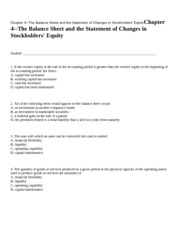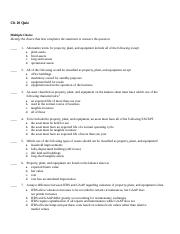
The net-of-tax income effects of a discontinued operation must be disclosed separately in the income statement, below income from continuing operations. The income effects include income (loss) from operations and gain (loss) on disposal. The gain or loss on disposal must be disclosed either on the face of the statement or in a disclosure note. The income (loss) from operations of the component is reported separately in discontinued operations on prior income statements presented for comparative purposes. A discontinued operation may still make a gain or loss in the accounting period it ceased operations in.
In financial accounting, discontinued operations refer to parts of a company’s core business or product line that have been divested or shut down and that are reported separately from continuing operations on the income statement. Each of the above items will likely provide the company with an additional tax liability or benefit. To allow the reader of the income statement to better understand the company’s ability to generate net income from continuing operations, an intraperiod tax allocation is performed.
This tax is often a future tax benefit because discontinued operations often incur losses. To determine the company’s total net income (NI), the gain or loss from discontinued operations is aggregated with that of continuing operations. Most elements of the income statement are not presented net of the intraperiod tax allocation.
A change in accounting principle occurs when a company changes from one generally accepted treatment to another. This means revising all previous periods’ financial statements as if the new method were used in those periods. In other words, for each year in the comparative statements reported, we revise the balance of each account affected.

What is the purpose of Interperiod tax allocation?
The financial accounting term intraperiod tax allocation refers to the distribution of income taxes to specific irregular items appearing in a financial statement. Intraperiod tax allocations occur within a given accounting period and allow the reader to understand the income tax implication of the irregular item.
At the end of the income statement is net income; however, net income only recognizes incurred or earned income and expenses. Sometimes companies, especially large firms, realize gains or losses from fluctuations in the value of certain assets. The results of these events are captured on the cash flow statement; however, the net impact to earnings is found under “comprehensive” or “other comprehensive income” on the income statement. Common examples are the choice among FIFO, LIFO, and average cost for the measurement of inventory and the choice among alternative revenue recognition methods.
AccountingTools
This means the above items are shown net of taxes, or the income tax benefit or expense is shown immediately below. We will start with other comprehensive income (OCI), for reasons that will become clear later on. Also known as comprehensive earnings, this is a catch-all classification for the items that cannot be included in typical profit and loss calculations because they do not stem from the company’s regular business activities and operations. Hence, they have to bypass the company’s net income statement—the sum of recognized revenues minus the sum of recognized expenses—which does include changes in owner equity. The tax expense is what an entity has determined is owed in taxes based on standard business accounting rules.
Specifically, we make those statements appear as if the newly adopted accounting method had been applied all along. Then we create a journal entry to adjust all account balances affected as of the date of the change.
Intraperiod Tax Allocation
- In financial accounting, discontinued operations refer to parts of a company’s core business or product line that have been divested or shut down and that are reported separately from continuing operations on the income statement.
- Each of the above items will likely provide the company with an additional tax liability or benefit.
For example, revenues, the cost of goods sold, and administrative expenses are not presented net of income taxes. These line items are all part of continuing operations, so there is no point in presenting each one net of tax – only the results of all continuing operations are presented net of tax.
This means that any income or expenses related to the channel’s operation will now fall under “Discontinued Operations” on the income statement (the one that will be generated for the same quarter he sold the station in). In Ned’s case, these amounts include sale revenues from ads, the cost of the severance packages, taxes, licensing fees, programming charges, interest expenses, etc. For accounting purposes, all the gains and losses for that division must be reported separately on the company’s income statement. This is so that these amounts can be distinguished from those of continuing operations. The total gain or loss from the discontinued operations is thus reported, followed by the relevant income taxes.
Continuing operations include net revenues and their related costs and expenses from ongoing operations. Discontinued operations, extraordinary items, and unusual items are excluded from continuing operations and reported separately; therefore, users of financial statements can decipher the various income streams. APB Opinion No. 11, Accounting for Income Taxes, used the term timing differences for differences between the years in which transactions affect taxable income and the years in which they enter into the determination of pretax financial income.
The financial accounting term interperiod income tax allocation refers to the distribution of income tax expense between accounting periods. This occurs due to a timing difference between taxable income and the accounting income appearing in the company’s financial statements. The single-step format first lists all revenues and gains included in income from continuing operations to arrive at total revenues and gains. All expenses and losses are then grouped and subtotaled, subtracted from revenues and gains to arrive at income from continuing operations. The multiple-step format reports a series (multiple) of intermediate totals such as gross profit, operating income, and income before taxes.
Timing differences create differences (sometimes accumulating over more than one year) between the tax basis of an asset or liability and its reported amount in financial statements. Other events such as business combinations may also create differences between the tax basis of an asset or liability and its reported amount in financial statements. All such differences collectively are referred to as temporary differences in this Statement. Income excluded from the income statement is reported under “accumulated other comprehensive income” of the shareholders’ equity section. The purpose of comprehensive income is to include a total of all operating and financial events that affect owners’ interests in a business.
However, often a discontinued operation was operating at a loss, so there may be some money realized from taxes at tax time. Keep in mind that these losses must be weighed against those departments or components of the business that are still in operation, which are most likely generating revenue.
What Is Included in Income from Continuing Operations?
A deferred income tax is a liability recorded on a balance sheet resulting from a difference in income recognition between tax laws and the company’s accounting methods. For this reason, the company’s payable income tax may not equate to the total tax expense reported.
The tax payable is the actual amount owed in taxes based on the rules of the tax code. The payable amount is recognized on the balance sheet as a liability until the company settles the tax bill.
What does Intraperiod mean?
An intraperiod tax allocation is the allocation of income taxes to different parts of the results appearing in the income statement of a business, so that some line items are stated net of tax. This situation arises in the following cases: Continuing operations (results of) are presented net of tax.
In the first set of financial statements after the change, a disclosure note would describe the change and justify the new method as preferable. These changes are accounted for as a change in estimate, rather than as a change in accounting principle. The remaining book value is depreciated, amortized, or depleted, using the new method, over the remaining useful life.